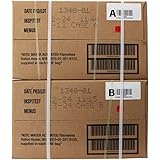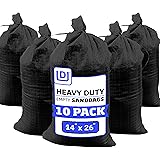Step 1: Create an Emergency Plan
Understand Your Risks
When it comes to emergency preparedness, the first thing I always do is take a good, hard look at the risks in my area. Each locale has its pitfalls—maybe it’s floods, earthquakes, or tornadoes. Call me paranoid, but knowing what’s likely to happen will help you craft a more effective plan. I often sit down and jot down what hazards I might face, just to have a clear picture.
I remember when I first moved to my coastal town and suddenly became aware of potential hurricanes. That little “what if” moment sparked me into action. I spent a weekend researching past storms and community resources. When you know your risks, you don’t just plan—you prepare.
It’s also worth chatting with neighbors or local community groups. They often have insights that can help fill in the gaps of my understanding. Plus, building community ties gives me that extra support network when crunch time hits.
Designate Meeting Places
An essential part of my emergency plan is deciding where my family and I would meet if things get chaotic. It’s kind of like preparing for a concert; you gotta have a plan if you get separated! I like to choose a primary spot and a secondary one—one close to home and another that’s a bit farther out.
For instance, if we had to evacuate fast, I’d probably pick a nearby park filled with trees; it’s spacious and relatively safe. For our secondary spot, maybe a friend’s house out of town. That way, if we can’t get back home, or if service is down, we know where to head.
And let me tell you, it’s super comforting knowing we all have our locations noted. I even recommend running through this plan with your family. Trust me; you don’t want to wait until a crisis happens to find out everyone has different ideas of what “go to the park” means!
Communication Plan
Next up on the list is communication. I often find people overlook this, but I believe having a solid communication plan is a gamebreaker. During an emergency, phone lines and service can go down, which can lead to confusion. So, I like to have a backup that’s old-school—think walkie-talkies or a simple printed list of important contacts.
In practice, we set up a group chat just for emergencies, including everyone who’d need to stay updated. But I also make sure everyone knows how to contact each other through other means, just in case. It’s been fun going over our plan; it brings in this extra element of family bonding.
== > What if ... Get a FREE Subscription to PREPARE
Your communication should be clear and straightforward. Sometimes, I even create a template that maps out contact numbers, meeting locations, and important info for my family to reference during a crisis. It’s not just a collection of numbers; it’s our lifeline.
Step 2: Build an Emergency Kit
Essential Supplies
Alright, moving on to something tangible—an emergency kit! I cannot stress enough how crucial this step is. My kit is like my mini survival toolbox, filled with essentials like water, food, and first aid supplies. Grab a sturdy backpack, folks. You can’t just toss these items in a drawer and forget about them!
I often spend some time making my kit personal. I include my favorite snacks, water purification tablets, and a blanket. It’s my little corner of safety, and it brings peace of mind that I’m ready should the worst happen. You know, those little apple chips really hit the spot when you’re stressed!
Also, don’t forget to check expiration dates regularly. A solid kit isn’t just about having stuff stuffed in it—it’s ensuring all the goodies are actually good when I need them!
Special Considerations
Your emergency kit should cater to everyone in your household. For me, this means considering the specific needs of my kids and pets. I make sure to have baby food, diapers, and medications handy, along with an extra leash and bowls for my dog.
I’ve learned the hard way that thinking through these needs early on saves a lot of hassle later. There’s nothing worse than when you’re knee-deep in chaos, and you realize you forgot something massive like your cat’s special food. Total bummer!
Additionally, I always suggest keeping copies of important documents in that kit too—things like IDs, insurance papers, and medical records. In the blur of an emergency, having these at my fingertips is a lifesaver!
Maintenance and Updates
So, once you’ve built your emergency kit, it’s time to play the long game—maintenance. Like I mentioned, regularly checking your supplies and replacing anything that’s expired is key. I like to set a reminder every six months to go through my kit and refresh items.
And hey, this could be an excellent family activity! You could turn it into a little party. Pop some music on, and as you’re going through the items, you can share experiences or even teach the kids about accessibility in emergency situations.
Sometimes I even add new items based on what’s been happening locally or just my gut instincts. Is there a new local danger? Should I have something specific to address it? Always tinkering can keep your kit rock-solid!
Step 3: Stay Informed About Emergency Alerts
Trusted Sources
Staying in the loop is vital! For me, getting emergency alerts directly from the local authorities is non-negotiable. I use apps and sign up for emergency notifications through local agencies, so I’m never caught off guard. Staying tuned in gives me the upper hand.
Plus, I always keep an eye on the radio. I found that even in crises, the good old radio can still provide solid updates when Wi-Fi is iffy or my phone is in and out. I always tell my neighbors to rely on multiple sources, so they don’t get caught relying on just one method.
It’s a wild world out there, and knowing where to get accurate information can save your sanity. When the winds start whipping, I always tune in to see what’s coming my way!
Connecting With the Community
Community engagement plays a massive role in emergency awareness. I often join local groups or forums that focus on disaster preparedness. It’s crazy how much knowledge you can gain just from attending a meeting or workshop. Plus, you meet some cool people along the way!
Being involved in community networking means we look out for each other. I might share my plans, and in return, my neighbors share theirs, which helps solidify a community safety plan. A tight-knit community keeps us all informed and ready!
If anything major were to happen, I’d know I have people I can count on besides my family. That gives me a warm fuzzy feeling, knowing we’re all in this together, looking out for one another.
Have a Backup Plan
No matter how well-informed I think I am, the unexpected occurs. That’s why I always brainstorm backup plans. If one communication method fails, what’s next? I promise you, thinking on your feet is a skill that’s sharpened during an emergency.
It’s super practical to consider how I may need to adapt depending on the situation’s specifics. Suppose the authorities say one thing, but then new insights come out, or the situation changes, what’s my next step? Flexibility is my jam during emergencies.
So with each crisis prep session, I remind myself that I cannot control everything out there, but I can get prepared and stay one step ahead through backup plans. It’s about being calm, cool, and collected in the chaos.
Step 4: Conduct Regular Drills
Practice Makes Perfect
One of the fun aspects of emergency preparedness is doing drills. Yup, you heard me right. I organize mini-practice sessions with my family to get everyone on the same page. It’s like fire drills from school but cooler—and less boring!
Lately, every couple of months, we designate a “drill” day. I’ll set off an alarm (thankfully, it’s not an actual emergency!) and have the kids practice their responses. These moments bond us while reinforcing the importance of being prepared.
Plus, they get to be active and engaged. It’s truly invaluable when they realize they can handle the stress of a situation. I tell them, “Practice now, so you know what to do when it’s the real deal!”
Engage Everyone
I’ve found that including everyone—little ones included—makes a significant difference. During our drills, I give the kids special roles, like “the lookout” or “supply grabber.” They trot around with a sense of responsibility, which keeps their interest piqued!
Even if my partners might roll their eyes, deep down, I know they’re secretly relieved that we’re all informed. I’ve watched these drills create natural conversations about safety in our family—something I cherish.
There’s something motivating about tackling this as a unit. It’s more of a family outing than a chore, and I feel everyone walks away learning something new!
Feedback and Improvement
After each drill, we sit down for a mini debriefing. I encourage everyone to share thoughts on what went well and what could use tweaking. This is such a critical step—being open to feedback improves our approach!
Owning up to the hiccups is totally fine. Maybe someone forgot their role, or they didn’t know where the emergency kit was. A good reflection ensures we continue getting better with practice.
We celebrate the successes too, such as how quickly they got to our meeting spot! It’s super important to recognize progress. Drills can feel intensive, but when lightheartedness is infused, it’s a balance of seriousness and enjoyment.
Step 5: Stay Healthy and Prepared
Personal Health Maintenance
As I wrap up my preparedness plan, I know that my physical health is a huge factor. In a crisis, I need to be fit enough to handle whatever comes my way. I can’t afford to be laid up when my family needs me most!
I’ve made it a point to stay active, eat right, and get required check-ups. Yoga, running, whatever I can squeeze into my life keeps my stamina up. It’s all about maintaining that edge, both physically and mentally. And hey, working out is often therapy and clears my mind.
Plus, having everyone else in the family on that health kick forms a secure and focused household! It becomes a habit, and before I know it, we’re all committed to staying healthy and prepared for anything that hits us!
Gathering Knowledge
Alongside staying fit, I prioritize ongoing education—whether through workshops, online courses, or local classes on CPR or first aid. Lifesaving skills provide confidence and give me actionable knowledge I can apply in emergencies.
Libraries and community centers are fantastic resources for discovering local training. It’s worth every penny, and often, these classes are free or low-cost. Plus, mingling with others also pushes the survival vibe—we are all in this together!
So, I always leave room for growth—whenever I’m learning something new, it’s like adding another tool to my emergency toolbox. Knowledge is empowering and keeps feeling prepared at the forefront!
Adapt and Evolve
Lastly, I make sure to adapt my plans and health strategies as life changes. As kids grow, their needs change. I need to be flexible with emergency strategies; adjusting as things evolve helps keep us ready. What I planned five years ago likely looks different today!
It’s essential to sit back every now and then to evaluate. Is there something that needs changing? Perhaps a new potential risk? Am I up-to-date with health recommendations? This ongoing adaptation keeps my family’s plan streamlined and effective.
Planning isn’t just a one-off task; it’s a never-ending cycle of being proactive. Life brings curveballs, but through this prep work—both individual and as a family—we face them together!
Frequently Asked Questions
1. What should be included in an emergency kit?
An emergency kit should contain essentials like water, non-perishable food, first aid supplies, flashlight, batteries, personal hygiene items, necessary medications, and copies of important documents.
2. How can one stay informed about local emergencies?
You can stay informed by signing up for local emergency alert systems, downloading relevant apps, and following community social media pages or local news stations to receive real-time updates.
3. What kind of drills should I perform with my family?
Practicing evacuation routes, safety drills for weather incidents, and communication plans are great ideas for family drills. Engaging in various scenarios can help everyone feel more prepared.
4. How often should I check my emergency supplies?
It’s best to check your supplies every six months to ensure nothing has expired and that everything is in working order. This is also a great time to update any items based on changing needs!
5. What if my emergency plan needs to be adjusted?
Adjustments are normal! Regularly review your emergency plans with your family, considering any life changes, new risks, or lessons learned from drills. Adaptability is crucial for effective preparedness.






